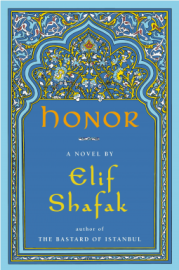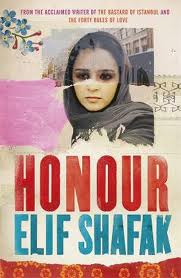Elif Shafak comments in her essay on identity The Happiness of Blond People about the stereotyping or tendency of books written by or about women from the East, that they often sport covers with an image of a veiled woman.
It is something that makes her other books stand out, because they don’t do that. The Bastard of Istanbul and The Forty Rules of Love (at least the editions that I read) have enticing covers that invite you to enter another world, depicting vibrant, warm colours and referencing stunning forms of Eastern architecture, curves, arabesques, spires and sparkling elements.
When I first spied the UK cover of her new book Honour I thought ‘Oh no’, not one of those books – I was disappointed as it looked like it belonged to that genre, the misery tale of a woman’s lot in a society where the veil is used as a symbol of varying degrees of oppression. That was before I read and reviewed the essay I refer to above, in which she cites those books with similar disdain.
It was some comfort to see that the US edition has nothing like that cover, preferring the safe symbolism of the open arches, inviting us in to take a look within its pages, no veils, no dark colours, no fear, no buying into outdated stereotypes. It would be interesting to know which cover attracts the most readers.
There is a plethora of lifestyles among Muslims, a variety of personal stories to consider; and yet only some of these stories come to the fore. They almost always happen to be the most problematic ones: we seldom hear about happy Muslims, in particular about happy Muslim women. Honour killings, female circumcision, child brides, the veil, gender segregation, lack of freedom… Gender is the number-one topic where the so-called Clash of Civilisations is manifest and crystallized. It is no coincidence that a considerable number of books related to Islam have female images on their covers, and in many, if not most cases, these females appear to be sad, silenced, secluded or suffering. Women with their mouths covered, or eyes peeking out from behind their hijab, or heads bowed miserably down… Elif Shafak, The Happiness of Blond People
Book covers aside, this is a very credible story, one that many women who have uprooted their lives and brought up or given birth to children in a foreign culture may relate to. Narrated by her daughter Esma, the story centres around the life of Pembe, identical twin to Jamila and one of eight educated daughters of a family raised in a Kurdish village, the desire and constant striving for a son eventually taking the mother in childbirth.
Life here is a precarious path for young woman, where one wrong step can easily lead to condemnation. One of the twins dreams of a life far away, the other seeks to learn from those around her, from nature and experimentation. Love is the sacrifice that will enable them to attain their so-called dreams.
Their adult lives are lived far from each other, Jamila becoming a renowned village midwife and Pembe, fulfils that desire to live elsewhere, travelling further than she ever dreams, her husband Adem, from Istanbul, brings her to live in East London where they will raise their three children Iskander, Esma and Yunis.
To her the future was a land of promises. She had not been there yet, but she trusted it to be bright and beautiful. It was a place of infinite potential, a mosaic of shifting tiles, now in a seamless order, now in mild disarray, for ever re-creating itself.
To him the past was a shrine. Reliable, solid, unchanging and, above all, enduring. It provided insight into the beginning of everything; it gave him a sense of centre, coherence and continuity.
Through the story, which alternates between 1940’s Kurdistan and 1970’s London, we come to know each of these family members and begin to understand how their individual and collective experiences has moulded them, Pembe and Jamila in their traditional village with its elders, family, traditions, superstitions; Adem with an alcoholic father and angst-ridden mother who eventually abandons her children, unable to cope with the Jeckyll and Hyde character of her husband. Each has been in some way touched by the repercussions of a ‘loss of honour’.
Iskander is raised in London with memories of his early life elsewhere, carrying memories of disappointment like molten rock deep within. He is sensitive to a vibe between his parents he doesn’t understand, something that makes him want to act. When his father leaves home and it becomes clear that his mother is moving on, the pressure of that molten rock within him causes him to explode.
 Honour touches on many great themes and then excels in sharing all the familial details, the interactions between its characters, the people and culture around them, to the point where we identify with each character as we spend time seeing things from their perspective and then experience a sense of anxiety knowing that these perspectives are likely to clash and the outcome will not be good.
Honour touches on many great themes and then excels in sharing all the familial details, the interactions between its characters, the people and culture around them, to the point where we identify with each character as we spend time seeing things from their perspective and then experience a sense of anxiety knowing that these perspectives are likely to clash and the outcome will not be good.
And then there is Zeeshan, a character who arrives unexpectedly, but one I recognise instantly, knowing of Shafak’s interest in Sufism and the work of the 13th century poet and philosopher Rumi; Zeeshan is a gift and offers a lifeline to Iskender representing hope.
Elif Shafak is a writer with an interesting perspective, as she herself says, she has one foot in Istanbul and the other travels and makes connections in cities around the world.
Writing that crosses cultures and observes characters doing the same invokes a sense of empathy, she is a writer whose work I will be following and whose city I look forward to visiting in May this year.
Note: This book was an Advance Reader Copy (ARC) provided by the publisher via NetGalley.




Love the sound of this read. Please bring a copy when you next come to London. I look forward to reading it in Agua Amarga over Easter. I worked amongst these families in London in the early 1970’s….. Andrew
LikeLike
I hope I can find you a copy, it was released in the UK much before this recent US release, my copy is on the kindle!
LikeLike
Pingback: Interrelatedness | Rayn@'s Spot
Dear Claire, this is a fabulous review of a fabulous book. It was a real Honour for me that you used my photo. With best wishes, Rayna
LikeLike
Thank you Rayna for allowing me to use such a wonderful image and most especially for the link from your blog, I have had an unprecedented number of visitors from Bulgaria!
LikeLike
Fascinating the contrast in covers. I would have guessed the US version would be the one to play up stereotypes.
LikeLike
I was surprised that it was the UK edition, but I have no idea how cover design and choice works, the differences between countries is incredible, they’re like completely different books!
LikeLike
Claire. what a beautiful review of what sounds a fascinating book…
And somehow it helps to know that all Muslim women are not oppressed!
LikeLike
Thank you Valerie, I think much of Elif Shafak’s work helps debunk that myth.
LikeLike
can’t wait to read this too!
LikeLike
A fine review of a powerful novel, Claire.
LikeLike
Thank you Celestine for your kind words, always.
LikeLike
It’s so interesting to see the two different covers. And to wonder why the publishers thought that one would attract more readers in one country rather than another. I would have loved to be behind-the-scenes in that meeting! I love that you brought in ‘The Happiness of Blonde People’ (a great read, which you introduced me to).
Out of curiosity, I went to amazon france to see the French book cover as I often read in French and the publishers have chosen a more abstract design, which is interesting….
Here’s the link:
LikeLike
I like the French cover too, for me it depicts the slow but subtle evolving change between generations and especially as they cross cultures, something is retained but much has changed and will continue to.
It is interesting too, now that this book has been long listed for the Women’s Prize for Fiction 2013 whether the cover will continue to be an issue, I have a feeling that it does put off some readers, as Iris mentions in her comment below – reading Shafak’s own quote about the stereotypical cover in her essay The Happiness of Blond People has at least helped one reader to ignore the cover and decide to read the novel.
LikeLike
Pingback: Not the Orange Women’s Prize for Fiction Longlist | Word by Word
That quote from ‘The Happiness of Blond people’ immediately makes me want to read Shafak’s books. It’s something that has bothered me for a few years now: how come the only stories we hear about women and Islam are the ones that highlight “oppression”, surely, that cannot be the only experience out there? Thank you for sharing. This had been on my list because of the Women’s Prize Longlist, but like you, I was a little hesitant wondering if it was going to be “that story”. Now I’ll definitely pick it up.
LikeLike
You are right and Elif Shafak is one of the best out there providing some balance in this area. She had a strong matriarchal influence in her own upbringing with positive role models and personally I love the influence of Rumi – she was a Rumi scholar although this has only appeared in her work recently and even in Honour there is a humorous reference. Now that she is based in London, I think we are going to hear more about and from her, a writer straddling East and West.
LikeLike
I have just finished my review on this book and I must say it is set to be my favourite book for the year. I too watch the typical veiled women cover with disdain and it doesn’t do Shafak the justice. She has put in more soul to her female characters than the ones that have been marketed as “oppressed”.
I hope your travel to Turkey this May would be a fruitful one as it is also my desired travel destination.
LikeLike
I feel sure she had no choice on that cover, especially after seeing that invitation from Elizabeth Gilbert to her fans to choose the cover of her next book The Signature of All Things, after being in complete disagreement with her publishers. When I saw the covers, I didn’t vote, but knew the white cover would win, it was obvious. What was more interesting was to discover in this article written afterwards, the writer’s instinct versus the publisher’s instinct, it showed the writer was more in tune with her audience than the publisher was. I am sure had Elif Shafak done the same thing, her fans would have chosen a different cover.
LikeLike
It is sad when the writer’s common sense is overridden by the more powerful publisher. I thought letting the readers choose the cover is good idea!
LikeLike
Pingback: Honour by Elif Şafak | JoV's Book Pyramid
Loved it! Thanks so much for the recommendation.
LikeLike
Pingback: Women’s Prize for Fiction Shortlist & Pulitzer Prize 2013 | Word by Word
Pingback: Meanwhile: Other Bloggers’ Links | Iris on Books
Pingback: Me Before You by Jojo Moyes | Word by Word
Pingback: Patasana: Murder at an Archaeological Dig | Word by Word
I am wearing veil myself, and I really think it’s our own choice to wear veil or not. Well, maybe because I’m living in Indonesia where we are free to practice our religious believe in any way we like. But this book is indeed a recommendation I’d like to pursue.
LikeLike
I agree with you, it is a choice and you also can choose different colours and styles, like men in the Gulf also choose to wear the ghutra/iqal, religion, culture, fashion, it’s all intertwined.
I don’t like when a publisher uses an image of a veiled women to imply some kind of oppression, I wonder if this book has been published in Indonesia and what kind of cover it shows. It says more about how they perceive the reading audience I guess.
LikeLike
yup, I wonder myself because it’s not yet published here in my country.
LikeLike
Pingback: The Shadow of the Crescent Moon | Word by Word
Pingback: 10 Books I’m Looking Forward to Reading in 2017, Mirrors, Blooms, Wonder, War, Not Nothing – Word by Word
Pingback: Three Daughters of Eve by Elif Shafak – Word by Word
Pingback: The Other Side of the Mountain by Erendiz Atasü tr. Elizabeth Maslen #WITMonth – Word by Word
Pingback: Berji Kristen: Tales From the Garbage Hills by Latife Tekin (1993) – Word by Word
Pingback: 20 Books of Summer 2023 – Word by Word
Pingback: The Island of Missing Trees by Elif Shafak – Word by Word